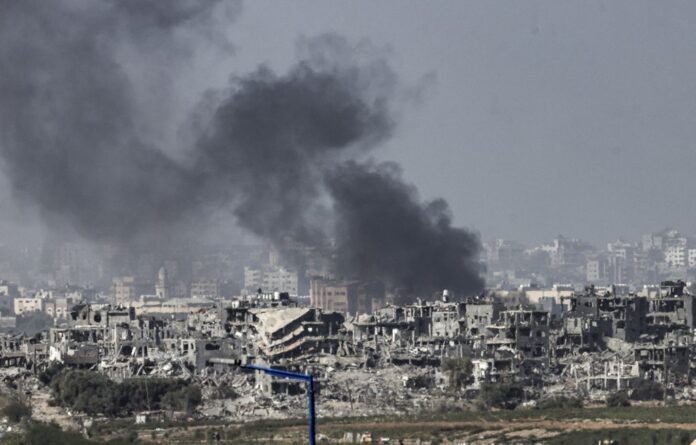This picture taken from the Israeli side of the border with the Gaza Strip, shows Israeli bombardment of the northern Gaza Strip today amid ongoing battles between Israel and the Palestinian Hamas movement. – AFP photo
PALESTINIAN TERRITORIES (Nov 9): Israeli air strikes pounded Gaza City today as soldiers battled street-by-street with Hamas militants, and tens of thousands of Palestinians desperate for safety fled their homes southwards in the besieged territory.
After more than a month of intense bombardment, hundreds of thousands of people remain trapped in a “dire humanitarian situation” in urban battle zones without enough food and water, the United Nations said.
Broken palm trees, distorted road signs and twisted lampposts marked the ruins of what was once north Gaza’s main arterial route, an AFP journalist saw while embedded with Israeli soldiers.
Israeli flags were flying over buildings at beach resorts in northern Gaza and there was little sign of any human presence amid the destruction.
The utter devastation came as Israel pressed an offensive launched in response to the Hamas attacks on October 7 that killed 1,400 people in Israel, mainly civilians, in the worst attack in Israel’s history.
The militants also took about 240 people hostage, among them babies and elderly people.
Vowing to destroy Hamas, Israel retaliated with a relentless bombardment and ground invasion that the Hamas-run health ministry in Gaza says has killed more than 10,500 people, many of them children.
The intense combat and the densely-populated coastal territory being effectively sealed off have led to increasingly dire conditions for civilians.
Tom Potokar, chief surgeon at the International Committee of the Red Cross, described the scene at the European hospital in Khan Yunis in southern Gaza as “catastrophic”.
“In the last 24 hours, I’ve seen three patients with maggots in their wounds,” Potokar told AFP.
A rare delivery of emergency medical supplies reached Gaza City’s main Al-Shifa hospital on Wednesday, just the second since the war began, the UN and World Health Organization said, warning it “far from sufficient to respond to the immense needs”.
Hostage negotiations
Israeli Prime Minister Benjamin Netanyahu has repeatedly rejected a ceasefire unless the hostages Hamas holds in Gaza are released.
According to a source close to Hamas, talks are underway for the release of 12 hostages, including six Americans, in return for a three-day ceasefire.
US National Security Council spokesman John Kirby said Washington “have a way to communicate with Hamas”, but that giving details could jeopardise the process.
“We’re doing everything we can to get these folks back with their families,” he said.
The United States has backed Israel’s rejection of a ceasefire, and G7 foreign ministers in Japan said Wednesday they supported “humanitarian pauses and corridors”.
As the war intensifies, discussions on the possible future of Gaza once the conflict ends have also grown, after Netanyahu this week said that Israel would assume “overall security” of the territory.
Kirby said Wednesday that it was plausible that “for at least some period of time” Israeli forces would remain in Gaza “to manage the immediate aftermath and security situation”.
Israel seized Gaza in the 1967 Six-Day War and withdrew in 2005. Two years later, Hamas took control and Israel imposed a crippling blockade.
In the longer term, US Secretary of State Antony Blinken has suggested the Palestinian Authority — which exercises limited autonomy only in parts of the occupied West Bank — should retake control of Gaza.
“It must include Palestinian-led governance and Gaza unified with the West Bank under the Palestinian Authority,” Blinken said on Wednesday, repeating the long-standing US call for a two-state solution.
But senior Hamas member Ezzat al-Reshq gave short shrift to the suggestion.
“All the powers of the world together would not be able to impose its conditions or its puppets” on the Palestinians, he wrote in a message on Telegram.
‘Let me take him home’
Israel has vowed to destroy Hamas, with its soldiers targeting their deep network of tunnels and underground bases, while air-dropping leaflets and sending text messages ordering civilians in northern Gaza to flee south.
The army said 50,000 people had fled their homes in the main battle zone of northern Gaza on Wednesday, a sharp increase in numbers from earlier this week, adding to the more than 1.5 million people already seeking safety in the south of the coastal strip.
The UN Office for the Coordination of Humanitarian Affairs (OCHA) confirmed the figure, and warned that conditions were “dire” in battle zones north of the central Wadi Gaza district.
“Hundreds of thousands of people remaining north of Wadi Gaza, including IDPs (internally displaced people), are facing a dire humanitarian situation and are struggling to secure the minimum amounts of water and food to survive.”
In the Indonesian hospital in Beit Lahia, in the northern Gaza Strip, a weeping father cradled the body of his two-year-old son Mohammed Abu Qamar, who died after an air strike.
“Please don’t put him in the morgue, let me take him home and I will bury him tomorrow”, his father Nidal said, as his wife screamed in grief alongside him.
‘Collective punishment’
UN rights chief Volker Turk condemned Israel over its bombardment and its orders for to Gazans to flee.
“The collective punishment by Israel of Palestinian civilians amounts also to a war crime, as does the unlawful forcible evacuation of civilians,” he told reporters at the Rafah border crossing with Egypt, the only route out of Gaza not controlled by Israel.
Efforts continue to resume the crossing into Egypt of wounded Palestinians and dual nationals after departures were stalled Wednesday, with Hamas blaming Israel for a failure to approve the list of injured to leave.
More than 100 trucks carrying aid crossed into Gaza from Egypt on Wednesday, OCHA said, taking the total to 756 since fighting began last month, fewer than what would normally have entered Gaza in just two days before the war.
“The aid getting through is a trickle,” Turk said. – AFP


